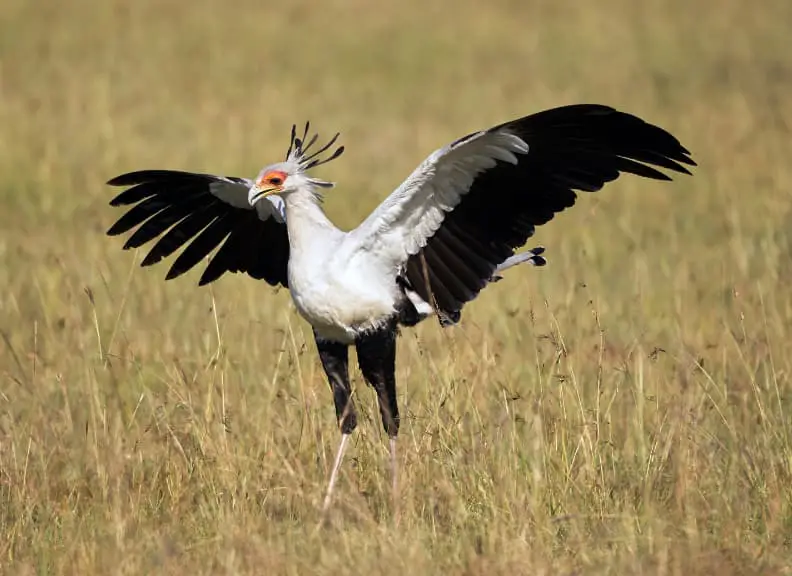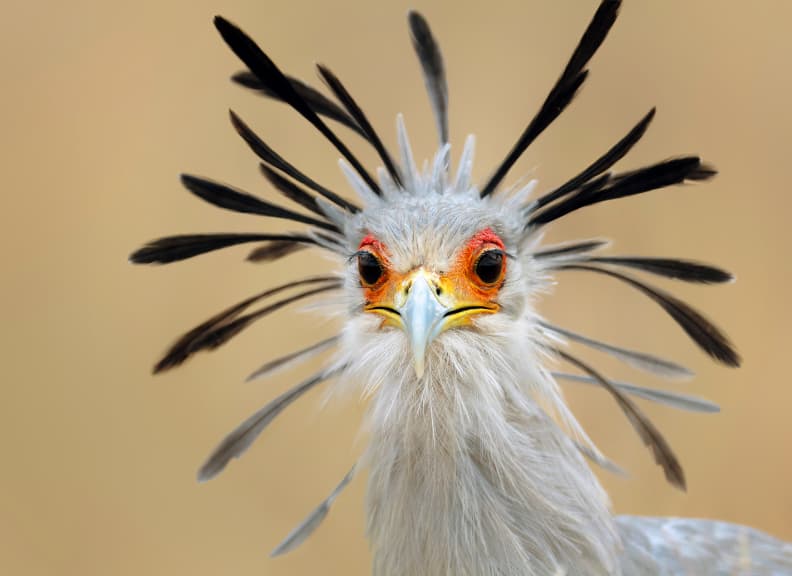- Unique Hunter: The secretary bird is one of the few birds of prey that hunts on foot, using its long legs to stomp on prey until it is subdued or dead.
- Striking Appearance: Standing tall with crane-like legs, the secretary bird has an eagle-like body, a hooked beak, and distinctive black feathers that fan out from the back of its head, resembling quill pens.
- Snake Slayer: It is renowned for its ability to kill snakes, even venomous ones like cobras, using swift, powerful kicks capable of delivering fatal blows.
- High Flyers: While they primarily hunt on foot, secretary birds are capable of flight and build their nests, which can be up to 8 feet wide, in the tops of thorny acacia trees.
- Endurance Walkers: These birds can cover a vast range of up to 20 miles a day on foot, striding across the savanna in search of food.
- Symbolic Bird: The secretary bird has been a symbol of power and protection since ancient times, featuring in Egyptian hieroglyphs and often associated with royalty and deity.
- Mating for Life: Secretary birds are monogamous and mate for life, performing elaborate courtship displays that include in-flight acrobatics and mutual preening.
- Powerful Vision: Their exceptional eyesight allows them to spot prey from great distances, which is crucial for their terrestrial hunting style.
- Conservation Status: Classified as vulnerable by the IUCN Red List, their population is declining due to habitat loss and other human-related factors.
- Cultural Icon: The secretary bird has been the national emblem of Sudan and is featured on the coat of arms of South Africa, symbolizing vigilance and authority.
The Stilt-Walking Secretary Birds of Africa
In the open African plains, there’s a bird so unique that it could have sprung from the pages of an explorer’s wildest journal. The secretary bird, with its long legs and quill-like feathers upon its head, is a sight to behold. It’s a bird that wears its name like a badge of honor, rumored to have gotten its name from the quill-like feathers behind its ears, resembling the office clerks of the 1800s who tucked pens behind their ears.
But make no mistake, this bird is far from desk-bound. The secretary bird is a hunter, a fierce predator that roams the grasslands on a quest for its next meal. With eyes sharp as daggers it is ready to unleash its secret weapon—its feet.

Imagine a creature that doesn’t swoop from the sky to catch its prey but instead marches across the savanna, engaging in a deadly dance. It spots a venomous snake slithering through the grass, and with a battle cry that pierces the air, the chase begins.
The secretary bird is a formidable foe for any serpent; it uses those long, powerful legs to deliver a series of rapid and precise kicks that would make any martial artist envious.
Where Can You See Secretary Birds?
Secretary birds can be seen throughout Southern Africa, particularly in the game reserves and national parks.
Can Secretary Birds Fly?
But the secretary bird’s talents don’t end there. It’s also a lover, not just a fighter. During mating season, the sky becomes their stage, and the birds perform an aerial ballet, looping and soaring in a display of courtship that draws the eyes of every creature in the savanna.
These birds are not only hunters and dancers but also architects. They build enormous nests, high in the acacia trees, where they will raise their young, teaching them the ways of the grassland and the secrets of their stilt-walking prowess.
And so, the secretary bird remains a symbol of the wild, untamed beauty of the African plains—a reminder that even in the sky, there are walkers, dancers, and warriors. With each step, they write their own chapter in the history of the savanna, a tale of resilience, grace, and the endless dance of survival.

Challenges in the Wild
Despite their fierce hunting skills and remarkable adaptability, secretary birds face challenges in the wild. Their habitats are threatened by human expansion, and their numbers are dwindling. But conservation efforts are in place to ensure that these majestic birds continue to grace the African skies. Organizations and wildlife enthusiasts are working tirelessly to protect the secretary bird and its home, ensuring that future generations can witness their grandeur.


